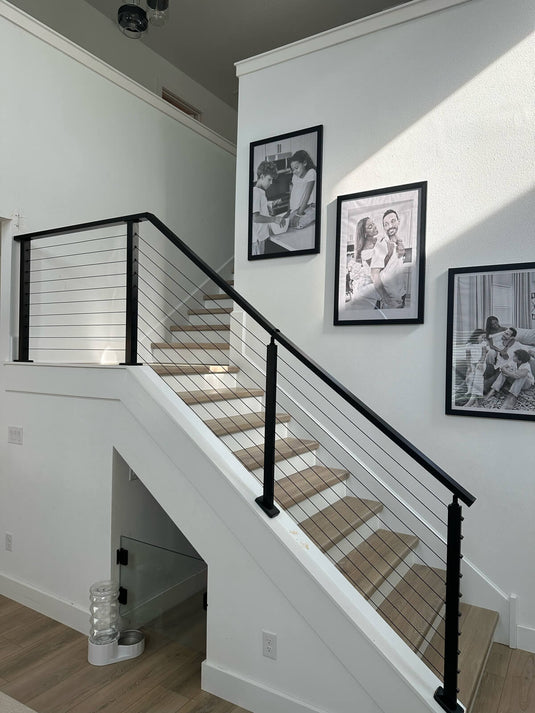TABLE OF CONTENTS
Cable Railing Systems: Enhancing Safety for Kids' Play Areas in Urban Homes
What Are Cable Railing Systems?
Cable railing systems are modern architectural elements primarily used in decking, stairways, and balconies to provide safety without obstructing views. These systems consist of horizontal or vertical cables made from stainless steel, which are held in place by posts and handrails. The defining characteristic of cable railings is their minimalist appearance, which not only enhances visibility but also complements a variety of design aesthetics.

Advantages of Cable Deck Railing for Urban Spaces
-
Cable deck railing systems offer several advantages that make them an excellent choice for urban homes, especially those with limited outdoor spaces. One of the most significant benefits is their durability. Made from high-grade materials like stainless steel, cable railings are resistant to corrosion, wear, and tear, making them ideal for withstanding various weather conditions without needing frequent maintenance. Additionally, the sleek design of cable deck railings ensures that they do not visually clutter a space, which can be particularly valuable in smaller, compact urban areas where every inch of visual real estate counts. This attribute not only makes the space feel larger but also ensures a clear view of children as they play, adding an extra layer of safety by allowing constant supervision.
-
Moreover, cable railing systems are versatile and can be customized to fit different styles and preferences. Whether you're aiming for a modern look or something more traditional, cable railings can be designed to meet those needs while maintaining their primary function—safety. This versatility also means that installing cable deck railing systems can potentially increase property value by enhancing both the aesthetic appeal and functional utility of outdoor spaces.
The Significance of Safety with Cable Railing Systems
Creating a safe play environment for children is a paramount concern, especially in urban homes where balconies and terraces serve as outdoor sanctuaries. Cable railing systems are a critical safety feature that addresses several risks associated with high-rise living.
Identifying Risks in Compact Play Areas
Urban play areas, often constrained by space, pose unique challenges when it comes to child safety. Traditional barriers might be too solid, blocking light and sightlines, or too flimsy, posing a risk of breakage. There's also the danger of children climbing over low or poorly designed railings. Cable railing systems circumvent these issues with their robust yet unobtrusive design, offering sturdy protection without tempting little climbers or obstructing adult supervision.
Evaluating Existing Safety Measures
Many urban homes may already have some form of protective measures in place, ranging from solid wall barriers to standard railings. While these may provide a physical barrier, they can often impede visibility and make spaces feel cramped. Cable railing systems offer a significant upgrade on these fronts. Their thin cables and less obstructive posts mean that parents can easily keep an eye on their kids from any angle, ensuring quick intervention if necessary. This visual access is crucial in preventing accidents and maintaining a secure environment where children can explore and play.
The Superiority of Cable Railing Systems for Child Safety
Key Safety Features of Cable Railings
-
The design and construction of cable railings prioritize child safety in several ways. First, the cables are tensioned to be highly resilient against force, meaning they won't give way if a child falls or leans against them. This tension also prevents sizable gaps, making it difficult for small bodies to slip through or get stuck between the cables. Secondly, the posts and handrails are constructed to withstand significant impact without budging, ensuring the structure remains intact over time.
- Meanwhile, the alignment of cables can be customized, typically running horizontally, which reduces the chances of adventurous climbers finding foot and handholds. Unlike vertical bar railings or chain links, cable railings present a smooth facade that discourages climbing, an essential consideration when tailoring an environment for curious kids.
Combining Aesthetics with Safety
- While safety is the priority, aesthetics cannot be overlooked, especially in settings where form is as valued as function. Cable railing systems score high on both counts. They offer a clean, modern look that can complement any architectural style, from contemporary to classic. When it comes to urban home design, where space and light are at a premium, the minimalist profile of cable railings is particularly beneficial, allowing natural light to permeate play areas and maintaining an open, airy feel.
- In addition, cable railing systems do not obstruct views, an aspect crucial for properties with scenic vistas. Parents want to ensure their children are safe without sacrificing the aesthetic appeal of their living spaces or their view of the outside world, and cable railings provide an elegant solution that satisfies all these requirements.

Applications in Real-World:
- The High Line in New York City – This famous urban park built on a historic freight rail line features sections with cable railings that ensure visitor safety while preserving views of the city and the park itself.
- Millennium Bridge, London – While not a building, this pedestrian suspension bridge across the River Thames uses cable railings extensively, providing clear sightlines along the walkway and contributing to its nickname, the "Blade of Light."
- Seattle Central Library in Seattle, Washington – The library is known for its striking contemporary architecture, which includes cable railing systems within its open-plan floors for an uninterrupted visual experience.
- Walker Art Center in Minneapolis, Minnesota – Known for its modern and contemporary art, the Walker Art Center uses cable railings for both indoor and outdoor spaces to maintain clean lines and open spaces.
- Portland Aerial Tram in Portland, Oregon – The platforms and waiting areas utilize cable railings, offering riders safety without compromising the expansive views during their commute.
Selecting the Appropriate Cable Railing System for Your Home

Critical Considerations for Cable Railings
- Material Durability: Stainless steel is the most common choice for cable railings due to its strength and resistance to corrosion and weathering. Aluminum and coated carbon steel options are also available and might be suitable depending on climate and budget.
- Cable Thickness and Spacing: The thickness of the cables can impact both the aesthetic and the structural integrity of the railing system. Typically, cables range from 1/8 inch to 3/16 inch in diameter. Closer cable spacing can provide more safety for homes with small children, as it reduces gaps.
- System Design: Horizontal cable railings are popular but may require more tension and maintenance to prevent sagging over time. Vertical cable systems are an alternative that might offer additional security for climbing-prone children.
- Installation Options: While some homeowners opt for DIY installation, professional installation can ensure that the railing is secure and complies with all local building codes. It's crucial to weigh the cost against the benefits of expert installation.
Ensuring Compliance with Cable Railing Safety Standards
- Building Codes: Local building codes often specify requirements for railing height, cable spacing, and overall design to prevent falls and ensure the structural durability of the railing system.
- Product Certification: Look for cable railing products that have been tested and certified by reputable agencies. Certifications indicate that the systems meet national or international safety standards.
- Manufacturer Reputation: Choose a manufacturer known for quality and safety. Research their product reviews, warranty offerings, and customer service to make an informed decision.
The Bottom Line
Cable railing systems present an optimal combination of safety, style, and durability for urban homes. They offer a contemporary look that doesn't compromise the functionality required for creating secure play spaces for children. By allowing clear sightlines, they enable parents to supervise their kids effortlessly, while the robust construction provides a steadfast safety measure against falls and accidents. Selecting and installing a cable railing system, considering factors like material durability, design, and adherence to safety standards, ensures that the system meets your specific needs.
As urban living continues to evolve, so does the importance of adapting our environments to fit our lifestyles. Cable railing systems embody this evolution, marrying form with function and providing a smart solution for modern urban dwellings.




